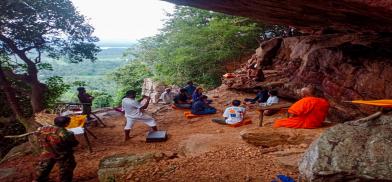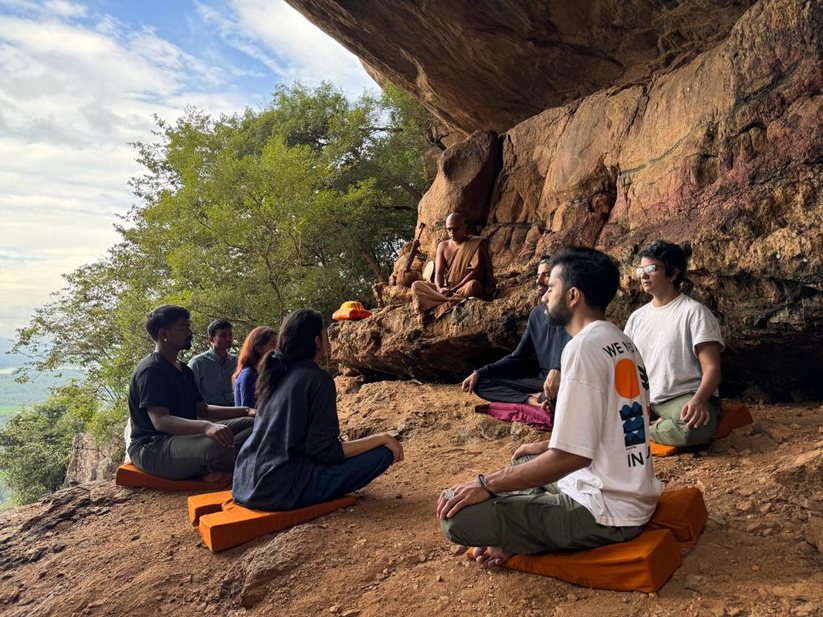Barefoot in Ridi Vihare: Learnings from a unique a people-to-people experience in the ‘silver caves’ of Sri Lanka
As someone from Karachi, where heritage and culture find little importance and are often forgotten, where the metropolis pushes the seashore backward, the Sri Lankan experience felt surreal. The land of Ridi Vihare held impeccable beauty and gave us much to learn and take back.

It has been several months since seven of us from the Indus Valley School of Art and Architecture left the hustle and bustle of Karachi to step into the serene environs of the Buddhist cave temples Ridi Vihare, or Silver Temples, in Sri Lanka. We have continued taking inspiration from that life-changing trip to produce work that was recently exhibited at the IVS Gallery.
The exhibition revived for us the warmth and grandeur, bright smiles, flower garlands, and traditional dance performances we experienced after landing in Colombo on 19 December last year. It was unlike anything we had come across before.
The Ridi Vihare area and village are breathtakingly beautiful and tranquil. We spent much of our time there walking. We did this barefoot like the locals, to experience nature more fully. The texture beneath our feet, of the clean rocks, and soil, and vegetation was unforgettable.
The monks and villagers who accompanied us were accustomed to the terrain. For us city dwellers, it took time to get used to the simple act of walking a distance. We had almost forgotten how to do that.

Immersive experience
The driving force behind the initiative was historian and art historian, Dr. SinhaRaja Tammita-Delgoda. Last year, he introduced Dimantha Thenuwara, a Sri Lankan IT professional-turned-explorer and climber, to some IVS faculty members. Dimantha had visited Pakistan and spent time at IVS. (Read about his experiences here).
This led to a formal invitation from the High Priest of Ridi Vihare, Ven. Buddharikkththa Sri Siddartha for students and lecturers to stay at the Temple and learn about the art, culture, music and gastronomy of ancient Sri Lanka.
Our college extended this opportunity to all students in the Fine Arts department. Supervised by two faculty members, five of us opted for the trip. Dr Tammita-Delgoda planned and organised our visit along with Jeevanthie Senanayake, Director General of Sri Lanka's Institute of Tourism & Hotel Management.
And now, months after Dimantha’s visit, we were being introduced to the cultural traditions of Sri Lanka and the rich history of the Ridi Vihare. It turned out to be an immersive experience.
The Temple dates back to the second century BCE. It is said to be the place that provided silver ore for the completion of Ruwanweli Maha Seya, one of the largest stupas in Sri Lanka.
The scenes of harmony with landscape and architecture were new for me, almost dreamlike.
We were guests of the locals, farmers and villagers, who looked after our needs. We stayed at modest accommodations provided by the monks. Walking the short distance to the temples, we saw that they were built in caves, blending into the natural landscape.
The paintings on the roof and walls of the caves are still intact, mostly restored during the Kandyan period of Sri Lanka’s history (1595-1815 CE). Every statue of the Buddha stands tall and sturdy with little or no damage.
As someone from Karachi, where heritage and culture find little importance and are often forgotten, where the metropolis pushes the seashore backward, the Sri Lankan experience felt surreal. The land of Ridi Vihare held impeccable beauty and gave us much to learn and take back.
Our stay at Ridi Vihare was also filled with flavour, nutrition and meaning. Everything we ate was sourced locally and cooked with minimal oil. Our meals were carefully planned and our hosts explained the benefits and the role of each ingredient in our digestive systems.
As someone who lives a busy city life, nutrition is usually the last thing on my mind. The tastes were a bit new and took time to adjust to, but it was a wonderful experience and a great break from processed foods. I tasted fresh pineapple for the first time in my life!
Meditation
The monks also introduced us to meditation practices and their values. Many of us went through much unlearning and relearning, including letting go of preconceived notions about meditation as a strict and inflexible practice.
One of my colleagues also observed the visual repetitions around us, from the sand drawings to lighting multiple oil lamps and the importance of having a routine. He termed all this as disciplinary meditation.
It was not just the meditation that moved us and gave us much to learn, but also the lifestyle of the monks. How detached they were from the worldly aspects and how they spent their time was so different from our own lives.
I remember a gift-giving ritual, where a monk was offered essentials, which he accepted on behalf of the sangha, the entire monk community. The monk then showed us the small bag in which he carried everything he needed. It was almost unbelievable how one could live with such minimal material belongings.
It was not just the monks who represented these values but everyone we met during our stay. It did not matter who they were or what status they held outside the temple in their worldly lives. Everyone walked barefoot, ate the same food, participated in the same activities and possessed humility.
While observing the monks, something that stayed with me was the behaviour and lifestyle of the child monks. They retained their child-like behaviour while remaining disciplined. They engaged in friendly banter from time to time, let themselves get curious, and they laughed. This was something I also noticed in the older monks, the laughter and jokes. They valued the human experience as much as the spiritual.
Ola leaf art
Another fascinating experience was being introduced to the ancient practice of the Ola Leaf books. The artists first boil the Ola palm leaves with various indigenous herbs. The leaves are then dried and treated, preserving them for hundreds of years.
The artists then etch characters and design into the dry leaves, followed by rubbing a mixture of charcoal and coconut oil for colour. The technique is similar to Western printmaking, but the Ola leaf tools and methods are more utilitarian. Each tool has a specific purpose, whether it is for writing or for punching holes in each leaf.
It was wonderful to see this ancient practice of writing and documenting on leaves not only being preserved but also practised, an example of the pride the people take in their heritage and legacy.
Learning about the Ola leaf art was particularly interesting because of our earlier introduction to printmaking at our Indus Valley School. In the West, printmaking has evolved over time, taking on many forms. The Ola leaf practice continues in its original form and each inscription is original – there are no copies.
Examining the visuals in the temples, we also noticed the differences in artistic technique and quality before and after colonial times. This felt familiar, as much of art in Southasia has drastically changed after colonisation.
In terms of architecture, the ancient temples in Ridi Vihare and the colonial-era ‘Dutch Hospital’ in Colombo were two sights that were poles apart. The Dutch Hospital reminded me of the many colonial leftovers in Karachi, the only difference being the lack of preservation in my own city.
It has been fascinating to see how the Ridi Vihare experience influenced each one of us individually. One student felt more connected to his own roots after witnessing and experiencing the temple. Another was inspired to infuse nature with art.
We have each taken with us varying learnings from the same observations. But it is safe to say that the experiences will stay with us for a lifetime.
(The writer is a third-year student of fine arts at the Indus Valley School of Art and Architecture, Karachi. By special arrangement with Sapan)









Post a Comment